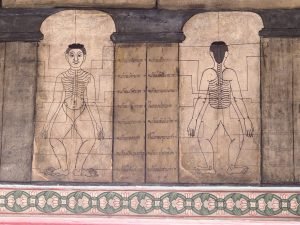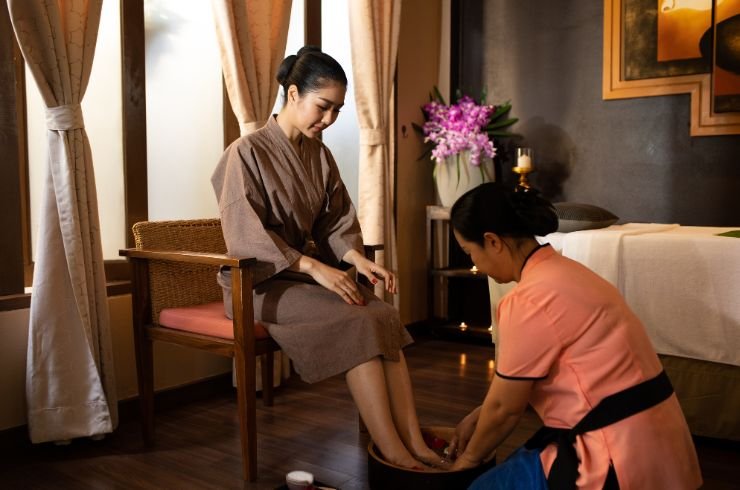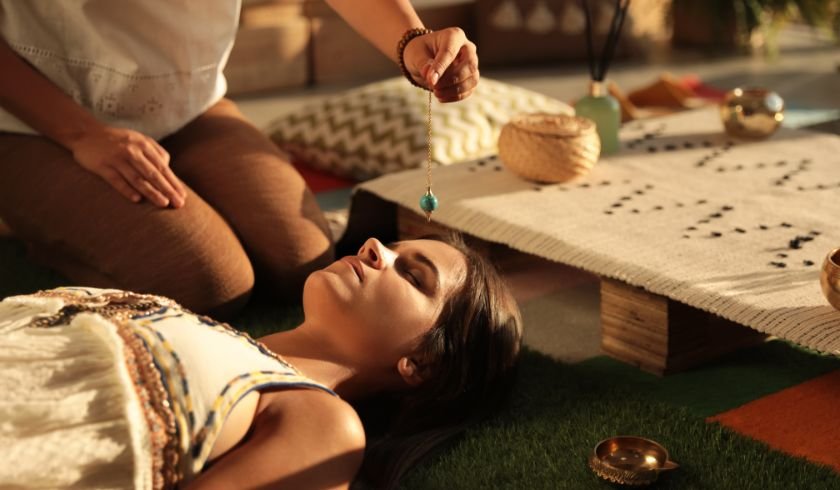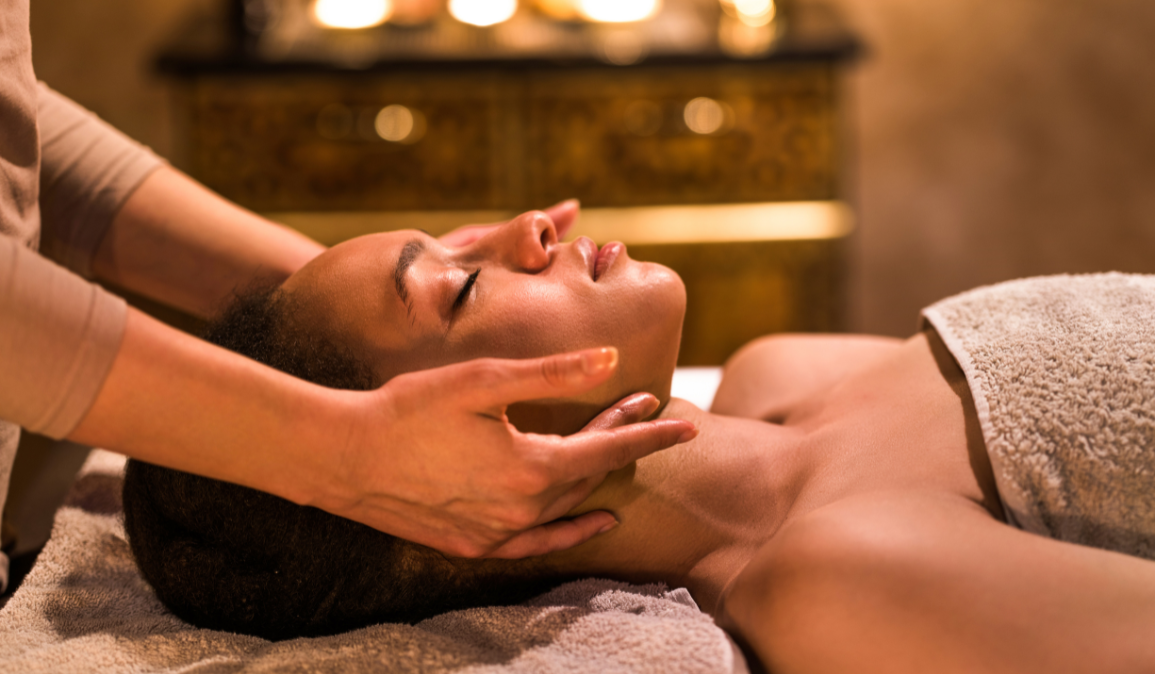Air pollution in Chiang Mai isn't just about smog; it's a wellness challenge where spas…
Ever wondered why Thai massages in Chiang Mai are famed for their health perks? Prepare for some eye-opening insights! We’re unveiling the ancient techniques that make these massages a game-changer for your well-being.
Thai massage health benefits include enhanced circulation, stress reduction, and improved flexibility and mobility. Chiang Mai’s spa scene is well-known for its skilled therapists and traditional methods. These spas excel in offering therapeutic benefits, enhancing overall wellness and mental relaxation for both locals and tourists.
Thai massages aren’t just about relaxation; they’re a blend of age-old practices with modern wellness insights. The gentle yet firm techniques used in these massages are known to boost blood flow and ease muscle tension.
Chiang Mai, with its rich tradition in Thai massage, offers some of the most authentic experiences. Here, expert therapists use their deep knowledge to target specific health needs, making each session a unique journey towards better health.
Thai Massage Health Benefits in Chiang Mai
Thai massage, a practice deeply rooted in Thai culture, offers a multitude of health benefits. It’s a unique blend of acupressure, yoga, and meditation techniques. Not only does it provide physical relief, but it also promotes mental well-being. Each session is an opportunity for holistic healing.
Reduced Stress Levels
- Thai massage effectively reduces stress by combining gentle movements with rhythmic pressure.
- It stimulates the release of endorphins, which are natural mood lifters, while lowering stress hormones like cortisol.
- This calming effect is not just immediate; regular sessions contribute to long-term stress management.
Improved Sleep Quality
- The relaxation techniques in Thai massage help in improving sleep quality.
- It calms the nervous system, leading to deeper, more restorative sleep.

- Many clients report a significant improvement in their sleep patterns after regular Thai massage sessions.
Promotes Relaxation
- Deep relaxation is achieved through the mindful and meditative aspects of Thai massage.
- The technique encourages a state of mental tranquility, which helps in relaxing the body.
- Clients often describe feeling both energized and deeply relaxed after a session.
Reduces Muscle Tension
- Thai massage is excellent for easing muscle tension. The stretching and kneading techniques help loosen tight muscles.
- It’s particularly beneficial for those who sit for long periods or have muscle stiffness due to stress.
- Regular sessions can lead to improved flexibility and decreased muscle soreness.
Improves Circulation
- The techniques used in Thai massage help enhance blood circulation throughout the body.
- Improved circulation aids in more efficient delivery of oxygen and nutrients to the body’s tissues.
- This can lead to better organ function and a boost in energy levels.
Increased Flexibility and Range of Motion
- The yoga-like stretches in Thai massage are key to increasing flexibility and range of motion.
- It’s particularly helpful for those with joint stiffness or mobility issues.

- Regular sessions can lead to improved physical performance and reduced risk of injuries.
Pain Relief
- Thai massage is known for its effectiveness in alleviating pain, including chronic pain conditions.
- It targets pressure points and uses stretching to relieve tension in the muscles and joints.
- Clients often report relief from back pain, arthritis, and headaches after a Thai massage.
Helps Relieve Headaches
- The massage focuses on pressure points in the head and neck region, which can alleviate headache pain.
- It’s particularly effective for tension headaches and migraines.
- Regular sessions can reduce the frequency and intensity of headaches.
Promotes Mental Calmness
- The meditative aspect of Thai massage promotes mental calmness and clarity.
- It helps in reducing anxiety and enhancing overall emotional well-being.
- Clients often report feeling mentally rejuvenated and more focused after a session.
Improves Energy Levels
- Despite its relaxing nature, Thai massage can actually boost energy levels.

- It balances the body’s energy systems, leading to a feeling of renewed vitality.
- Many find that they have increased stamina and reduced fatigue after regular sessions.
Each of these benefits contributes to the holistic impact of Thai massage on a person’s health. The practice is more than just a physical therapy; it’s a pathway to harmonizing the body and mind, a principle deeply ingrained in the Thai massage tradition. As a therapy, it offers a unique experience that goes beyond the conventional understanding of massage, embracing both the physical and spiritual aspects of wellness.
Spa Etiquette when getting a Thai Massage in Chiang Mai
When visiting a spa for a Thai massage, it’s important to follow certain etiquette. First, arrive on time or a bit early to relax before your session. It’s

respectful to the practitioners and helps in getting the full experience.
Remember to turn off your phone or switch it to silent mode to maintain a tranquil environment. Communicate your comfort levels and any specific pains or areas of focus to the therapist.
It’s customary to wear loose, comfortable clothing since Thai massages involve stretching movements. Most reputable spas provide Thai massage outfits so you don’t really need to worry about this.
Lastly, tipping is appreciated but not mandatory; it’s a way to show gratitude for the service received.
What to Expect During a Thai Massage Session
During a Thai massage, expect a blend of acupressure and stretching. Unlike typical Western massages, you’ll likely remain fully clothed, and no oils are used. The therapist will guide you through various stretches and postures, mimicking yoga movements.
You’ll also experience gentle pressure along your body’s energy lines to release tension and enhance circulation. Communication with your therapist is key; let them know if any stretches or pressures are too intense. The aim is to balance and energize your body, leaving you feeling refreshed and relaxed.
Pre-Thai Massage Steps
Preparing for a Thai massage can enhance your experience. Eat lightly before your appointment as heavy meals may cause discomfort during the stretching. Hydrating before the session is beneficial, but avoid drinking large amounts just before to prevent discomfort.
Wear or bring comfortable clothing that allows for movement, such as yoga attire. It’s also advisable to avoid wearing jewelry and to have a brief shower beforehand. Mentally preparing yourself to relax and be present during the massage can greatly enhance the experience.
Post-Thai Massage Steps
After your Thai massage, it’s important to take certain steps to maximize the benefits. Drink plenty of water to help flush out toxins released during the massage. It’s normal to feel a bit sore after the session, so rest if needed.
Avoid heavy physical activity immediately after the massage. Some people feel energized while others feel relaxed; listen to your body and respond accordingly. If you enjoyed the experience, consider scheduling regular sessions to maintain the benefits.
Tips for First-Timers
For those new to Thai massage, here are some tips to make your first experience enjoyable. Research and choose a reputable spa or practitioner. Don’t hesitate to ask questions before booking your session.
Be open-minded about the experience, as Thai massage differs significantly from Western massage techniques. Communicate openly with your therapist about your comfort levels. Finally, approach the experience with an open heart and mind, ready to embrace the holistic benefits of Thai massage.
Thai Massage for Relaxation and Wellness
Thai massage leads to deep relaxation by working on your body’s energy lines. Imagine these as highways of energy flowing through you. The therapist’s careful pressing and stretching help clear any blockages, like a traffic jam clearing up.
This makes you feel more relaxed as your body’s energy moves freely. It’s like a deep breath for your muscles and mind, leaving you feeling light and peaceful.
For wellness, Thai massage does more than just relax you. It improves your circulation, getting more oxygen to your cells, which helps your body heal and renew itself.
The stretching can also increase your flexibility and range of motion, making everyday movements easier and pain-free. Over time, regular sessions can lead to better posture, less pain, and a stronger immune system. It’s like giving your body a regular tune-up, so you feel healthier and more energetic in your daily life.
When is a Thai Massage not Suitable?
Thai massage, while beneficial for many, may not be suitable for everyone. People with certain medical conditions should exercise caution or avoid it altogether. For example, individuals with heart conditions or high blood pressure might find the rigorous nature of Thai massage too stressful for their condition.
Similarly, those who have recently undergone surgery should wait until they have fully recovered before considering a Thai massage, as the intense stretching could impact the healing process.
Pregnant women, particularly in their first trimester, should also approach Thai massage with caution. Specialized prenatal massages are more appropriate in these cases.
Additionally, individuals with osteoporosis or who are at a high risk of blood clots should avoid Thai massage, as the deep pressure and stretches could be harmful. It’s also important for those with acute injuries, like fractures or severe burns, to avoid Thai massage until they have fully healed.
Thai Massage vs Western Massages
Thai massage and Western-style massages like Swedish or deep tissue offer different experiences and benefits. It is more active and involves a lot of stretching, making it similar to yoga.

It’s great for improving flexibility and energy flow through the body. In Thai massage, you remain fully clothed, and no oils or lotions are used.
It’s a holistic approach that aligns the body’s energies and is often considered more vigorous than Western massages.
On the other hand, Western massages typically focus on relaxation and relieving muscle tension. They often involve the use of oils or lotions, and you’re usually partially clothed or covered with sheets.
Techniques like long strokes, kneading, and circular movements are common. These massages are excellent for overall relaxation, improving blood circulation, and easing muscle pain.
Ultimately, the choice between Thai massage and Western massages depends on your personal preferences and health needs.
If you’re looking for an energizing, stretching-focused experience, Thai massage is a great choice. However, if relaxation and muscle relief are your main goals, a Western-style massage may be more suitable.
History of Thai Massage

Thai massage boasts a history that spans over 2,500 years, originating in Thailand as a healing art developed by Buddhist monks. Jivaka Kumar Bhaccha, the Buddha’s physician, is often revered as the founder of Thai massage, a testament to its deep roots in wellness and spirituality.
Passed down through generations, Thai massage has evolved, incorporating elements from diverse cultures such as Indian, Chinese, and Southeast Asian.
Traditionally practiced in temples, it was an integral part of the monks’ healing practices. This rich blend of influences has made Thai massage not just a therapeutic practice but a cultural treasure.
In recognition of its profound cultural significance and historical value, Thai massage was inscribed on the UNESCO Intangible Cultural Heritage list.
This prestigious status underscores its importance as a symbol of traditional knowledge and cultural continuity.
The UNESCO heritage status highlights the global recognition of Thai massage as not only a therapeutic practice but also a cherished cultural tradition, bringing to the forefront its unique blend of physical therapy, spiritual practice, and cultural storytelling.
The Philosophy Behind Thai Massage
The philosophy of Thai massage is deeply connected to the principles of energy balance and holistic wellness. It’s based on the belief that the body has ten main energy lines, known as ‘sen,’ through which life force flows.
Blockages or imbalances in these lines can cause illness and discomfort. Thus, Thai massage aims to clear these blockages and restore balance to the body and mind. It’s seen not just as a physical therapy, but as a spiritual practice as well, promoting harmony between body, mind, and spirit.
Traditional Techniques and Practices
Traditional Thai massage techniques are quite unique. The practice often involves a combination of stretching, pulling, and rocking motions to relieve tension and enhance flexibility. Unlike Western massages, no oils or lotions are used, and clients remain fully clothed.
The massage is traditionally performed on a mat on the floor, allowing the practitioner to use their body weight to apply pressure. This approach allows for a wide range of movements and deeper pressure, which can be more effective in releasing muscle tightness and improving circulation.
Many modern spas use wider, Western-style (with face holes) massage tables which allows for more movement to accommodate Thai massage techniques.
The Ancient Roots of Thai Massage in Chiang Mai
Chiang Mai, a cultural jewel in Northern Thailand, is renowned for its traditional Thai massage, deeply rooted in holistic healing.
For centuries, this city has been a key custodian of Thai massage, preserving its ancient art and teachings. Its esteemed massage schools impart original techniques and philosophies, nurtured by expert practitioners.
More than mere physical therapy, Thai massage in Chiang Mai integrates energy balance and mind-body connection, promoting physical, mental, and spiritual harmony.
Students master energy manipulation through hands-on practice and meditation, making this massage form a blend of relaxation, flexibility enhancement, and overall health improvement, symbolizing the unique mind-body synergy of the local culture.
Thai Massage in Thailand
In Thailand, Thai massage is more than just a wellness treatment; it’s a part of everyday life and culture. It’s widely available, from luxury spas in big cities to traditional massage shops in smaller towns. In Thai culture, massage is a communal activity, often shared among family and friends as a way to bond and care for each other.
The practice is also integrated into the healthcare system in Thailand, recognized for its therapeutic benefits. As such, Thai massage therapists are highly respected and seen as healers in their communities.
This overview gives a glimpse into the rich tradition and cultural significance of Thai massage in Thailand and especially in Chiang Mai. Each aspect, from its history and philosophy to its techniques and practices, contributes to the uniqueness of this ancient healing art.
Can Tourists Enjoy the Benefits of Massage in Chiang Mai?

Absolutely, tourists can enjoy a wide array of benefits from massages in Chiang Mai. Beyond the traditional Thai massage, the city offers various modalities like Swedish, deep tissue, and aromatherapy, catering to diverse preferences and needs.
Chiang Mai is dotted with numerous spas and massage shops, especially in tourist-friendly areas, making it convenient to find a place that suits your style and budget. Many reputable spas even offer transportation or shuttle services, ensuring a hassle-free journey to relaxation.
The warm hospitality, serene settings, and often bilingual staff add to the appeal, making it easy for tourists to unwind and immerse in the healing experiences Chiang Mai has to offer.
Whether you’re looking for a quick foot rub after a day of sightseeing or a full-day spa retreat, Chiang Mai’s massage scene is designed to pamper and rejuvenate travelers from all walks of life.
Choosing a Thai Massage Spa in Chiang Mai
 When choosing a Thai massage spa in Chiang Mai, there are several factors to consider. First, research the spa’s reputation. Look for reviews and testimonials from previous clients.
When choosing a Thai massage spa in Chiang Mai, there are several factors to consider. First, research the spa’s reputation. Look for reviews and testimonials from previous clients.
It’s important to select a spa that is well-regarded for its service quality and hygiene standards.
You should also consider the types of massages offered. Some spas specialize in traditional Thai massages, while others may offer a blend of techniques.
The ambiance of the spa is another key factor. A calm, serene environment contributes significantly to the overall experience. Visiting the spa beforehand, if possible, to get a sense of the atmosphere can be helpful.
Additionally, consider the qualifications of the therapists. A good spa should have experienced and trained therapists who understand the nuances of Thai massage techniques. Lastly, price is a consideration, but it shouldn’t be the only one. Sometimes, paying a bit more can ensure a better quality experience.
Choosing a Thai Massage School in Chiang Mai
If you’re interested in learning Thai massage in Chiang Mai, choosing the right school is crucial. Start by considering the school’s accreditation. It’s important to attend a school that is recognized and offers certifications that are respected in the field.
Look into the curriculum to ensure it covers both the practical and theoretical aspects of Thai massage.
The experience and qualifications of the instructors are also important. Teachers should have not only a deep understanding of Thai massage but also the ability to teach it effectively. Check if the school offers hands-on training, as practical experience is key in learning massage techniques.
Additionally, consider the class size and structure. Smaller classes often mean more personalized attention and a better learning experience.
Another aspect to consider is the duration of the courses offered. Some schools offer short, intensive courses, while others have longer programs. Choose a course length that fits your schedule and learning style.
Finally, read reviews and testimonials from former students to get a sense of the school’s reputation and the experiences of past attendees. This can give you valuable insights into the quality of education you can expect.




